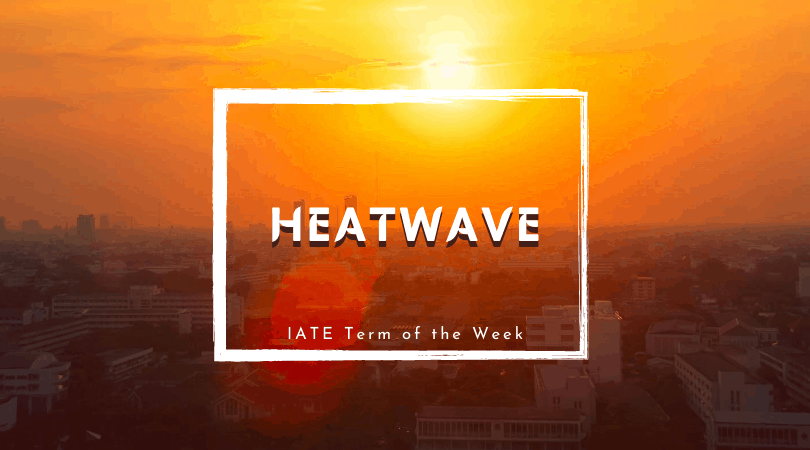‘Heatwave’ is the compound word created in order to describe a period of unusually hot weather which “breaks on the shore of our everyday lives”. The first known use of the word was recorded in 1893, whereas the first recorded heatwave prior to 1901 took place in 1540, when an extreme heatwave in Europe lasted 11 months and was accompanied by an extreme drought. According to the official list of recorded heatwaves, Argentina faced a “Week of Fire” in the first eight days of February 1900. The heatwave had terrible effects on the cities of Bueno Aires and Rosario, which were under temperatures of up to 37o C (99oF) and a very high index of humidity that elevated the sensation of heat to 49 oC (120 oF), severely affecting the health of people and causing at least 478 fatalities. There are many more recorded cases of extreme heatwaves costing many peoples’ lives, like the 1987 Heatwave of Greece which lasted from 20 to 31 July and caused the death of more than 1,000 people in Athens.
The worrying factor is the ongoing increase in the number of heatwaves. Where previously, incidental heatwaves were striking in various areas of the world over the span of a century, nowadays, we are faced with increasing cases of heatwaves appearing within a single year. A noticeable example is last year: in 2019, 9 heatwaves affected Europe, Australia and the United States as well as areas of Asia.

Heatwaves are extreme weather events, but research shows that climate change is making these events more likely. A scientific study by the Met Office of the 2018 summer heatwave in the UK showed that the likelihood of the UK experiencing a summer as hot or hotter than 2018 is a little over 1 in 10. It is 30 times more likely to occur now than before the industrial revolution because of the higher concentration of carbon dioxide (a greenhouse gas) in the atmosphere. As greenhouse gas concentrations increase, heatwaves of similar intensity are projected to become even more frequent, perhaps occurring as regularly as every other year by the 2050s. The Earth’s surface temperature has risen by 1 °C since the pre-industrial period (1850-1900).
According to the World Weather Attribution (WWA) initiative which conducts analyses of recent extreme weather events trying to understand the link between the climate crisis and these extreme weather events, finding a way to face the climate crisis is important. Not only does it help us more easily see trends and patterns in the climate, but also to make better plans for a hotter future. “We’re going to get more days where we get certain hot temperatures, which cause problems to our infrastructure, such as roads or railways, or electronic networks, which struggle in the heat,” says Ed Hawkins, professor of the University of Reading in the National Centre for Atmospheric Science. “When we get these events, they’re very useful for talking about how we get used to them and learn how to deal with them better.”
Apart from the cost of human lives, especially of those who are already vulnerable due to serious or long-term illnesses, the effects of heatwaves are enormous on economy, social sectors and ecology. For example, globally, 2% of total working hours are projected to be lost every year, either because it is too hot to work or because workers have to work at a slower pace. Lost productivity from heat stress at work, particularly in developing countries, is expected to be valued at $4.2 trillion dollars per year by 2030, further driving inequality. The agricultural sector, where 940 million people earn their livelihood, is set to be hit harder by hotter temperatures, pushing workers, crops and livestock past their physiological heat and drought tolerances. This will result in lost labour, in smaller harvests for farmers, higher prices for consumers, and negative impacts on livelihoods. Water shortages and increased stress for plants, particularly in arid regions has the effect of reducing plant growth, the basis of energy production and the food chain, with an overall drying-out of the landscape. Over time, deep permafrost warming and thawing could cause landslides and rock falls, furthering negative ecological impacts.
References
DW news, “Germany’s Green Party Leader wants better heatwave plans”, [ONLINE] Available at https://www.dw.com/en/germany-greens-heat-heatwave-plans-future-environment-climate/a-54518805 [Accessed 12 August 2020]
Future Earth Organization, “Heatwaves”, Finextra, [ONLINE] Available at https://futureearth.org/publications/issue-briefs-2/heatwaves/ [Accessed 12 August 2020]
Heatwave: how to cope in hot weather, [ONLINE] Available at https://www.nhs.uk/live-well/healthy-body/heatwave-how-to-cope-in-hot-weather/ [Accessed 12 August 2020]
Lee, Alex ““Why is this heatwave lasting so long? Blame Climate Change”, [ONLINE], Available at https://www.wired.co.uk/article/when-will-the-heatwave-end, [Accessed 12 August 2020]
List of Heatwaves, [ONLINE] Available at https://en.wikipedia.org/wiki/List_of_heat_waves [Accessed 12 August 2020]
Online Cambridge Dictionary. 2020. Meaning of Heatwave by Online Cambridge Dictionary [ONLINE] Available at https://dictionary.cambridge.org/fr/dictionnaire/anglais/heatwave [Accessed 12 August 2020]
Online Merriam Webster Dictionary 2020 Meaning of Heatwave by Online Merriam Webster Dictionary [ONLINE] Available at https://www.merriam-webster.com/dictionary/heat%20wave#h1


